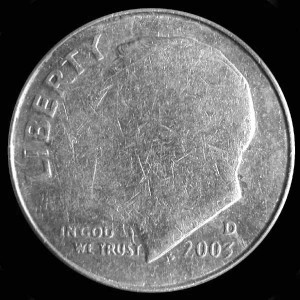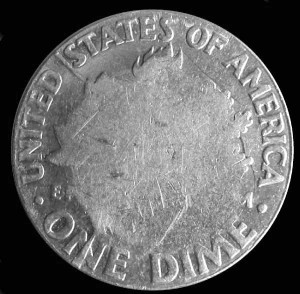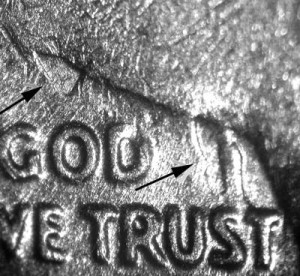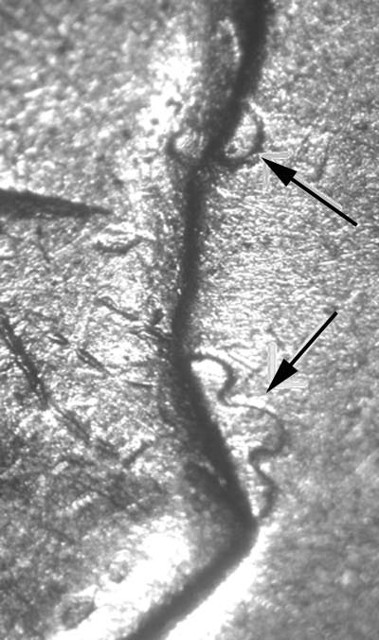ADC-10c-2003D-01
This is an unusual combination error coin. It has both a collapsed die and a die clash.
The full story on this unusual dual error coin was written by Mike Diamond and contained in Coin World.
Massive die collapse leaves dime without central design


By Mike Diamond-Special to Coin World | Aug. 20, 2011 10:00 a.m.
Article first published in 2011-08-29, Expert Advice section of Coin World
Weakness or absence of centrally located design elements on both faces of a coin may arise from a variety of causes. As discussed in previous columns (March 1, 2010; Dec. 20, 2010; Feb. 7, 2011; April 11, 2011), it can be caused by a moderately weak strike, a very weak strike in combination with a strongly upset planchet, accumulations of die fill (“grease”), an abnormally hard planchet, a rolling indentation error or a collapsed die.
A singular expression of the last category was recently discovered in pocket change by Roland Avery in the form of a 2003-D Roosevelt dime. He first reported his find on the Coin Community Forum devoted to errors and varieties (www.coincommunity.com/forum/forum.asp?FORUM_ID=5) where majority opinion held that it was vandalized outside the Mint.
At 2.24 grams, the coin’s weight falls within the normal range of variation (average weight of 2.27 grams). Although perfectly round, at 17.76 millimeters the coin is only about as wide as an unstruck planchet. Normal dimes average 17.91 millimeters in diameter.
Avery’s dime was struck with a reverse die that had collapsed in the center. It would therefore be classified as a “die subsidence” or “sunken die” error. The resulting depression was so deep that coin metal was unable to rise high enough to fill the recesses of the die face.
At the same time, the planchet buckled and bulged into the depression, following the path of least resistance. This left the obverse face with a concave cross-sectional profile that is also devoid of many design elements.
As one would anticipate, the featureless areas on the obverse and reverse faces retain the original tumbling marks of the unstruck planchet.
The reverse bulge is higher than the design rim. As a result, the touch of a finger on the obverse rim causes the coin to rock back and forth.
The collapse of the reverse die appears to be the result of plastic deformation, rather than an abrupt, brittle cave-in. The boundary separating the featureless bulge from the surrounding die-struck ring is softly defined, instead of sharply demarcated by semi-circular die cracks or a cliff-like zone of vertical displacement.
Even so, there is evidence of brittle fracture elsewhere. Two wide radial die cracks cross the die-struck perimeter. One splits apart the n of one, while the other falls into the gap between united and states. These cracks may have resulted from the extra stresses applied to the outer ring of the die face, which had to absorb the full impact of each strike after the center of the die face retreated.
Both faces of this 2003-D Roosevelt dime show strong clash marks. It’s unclear if these are connected in any way to the die subsidence error.
By 2003, the vast majority of circulation-quality dimes were being struck with an inverted die setup, with the reverse die functioning as the hammer die. Still, a few older-style Bliss presses remained in use at the Denver Mint as recently as the middle of 2005. These are associated with a conventional die setup, with the reverse die acting as the anvil die. I am therefore unable to determine which position was occupied by the reverse die that struck Avery’s dime.
Because the center of the reverse face is unstruck, it’s impossible to determine whether, and to what extent, design details in the die face were distorted or smoothed-out by the central collapse. Other die subsidence errors associated with split dies do show a loss of clarity (and, in some cases, total loss) of design details. Elements bordering the central bulge show no distortion as they disappear into the void.
A final peculiarity is the failure of the coin’s periphery to show any evidence of increased effective striking pressure. Because the center of the reverse die had collapsed, the entire tonnage of the strike would have been concentrated on the outer ring. This should have resulted in strong reeding and finning of the rim. Instead, reeding is not particularly strong anywhere and is absent from 4:30 to 9:00. Reeding is best developed at around 12:00 and gradually weakens in both directions until it disappears. The design rim is normal and shows no sign of finning. These observations, together with the abnormally small diameter, clearly indicate that striking pressure was somewhat reduced, either as the result of increased minimum die clearance or reduced ram pressure.This is an unusual combination error coin. It has both a collapsed die and a die clash.
The pictures to the left show a close up of the clash marks.

